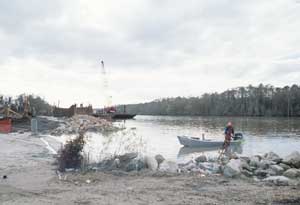
Redfish Bay lives up to its name during the springtime.
I received an e-mail this month from a reader (I’ll call him Joe) who is having carburetor troubles. He wrote that he has a 1987 model boat with an XYZ brand outboard. When he first bought the rig, he had problems with water getting in the gas. The carburetors were rebuilt twice before the cause of the problem was discovered.
It seems that the gas-tank vent was located too far back on the boat, and spray was entering the tank through the vent line. He had the vent relocated, and a water-separating fuel filter was added to the system to keep out any future water contamination. Since that time, the engine has been trouble-free.
Now that his engine is older, he has experienced a new problem. Joe stated that the engine will not start when it’s cold unless he takes the cover off the carburetors and shoots a blast of carb cleaner into the throats. This was recommended to him by a “backyard” boat mechanic.
After the motor starts that first time in the morning, it is good for the rest of the day. Joe was told that when motors get old, sometimes this is the only way to start them when cold — and once you start doing this, it will be required by the motor forever.
My first reaction to this e-mail was to nearly fall on the floor laughing. I told Joe that his “backyard” mechanic was 100-percent wrong.
First, you should never spray any type of starting fluid into a 2-cycle motor because a 2-cycle engine gets its lubrication from the oil that is mixed into the gasoline. Carburetor cleaner or starting fluid has no lubrication.
Second, starting fluid is much more volatile than gasoline (thus allowing the motor to start easier), but you take the risk of over-revving the motor if you accidentally have the throttle too far advanced.
Third, the statement about the motor being addicted to starting fluid sounds like it has a drug problem. If all the settings are correct and the primer bulb on your gas hose is good, then it should start easily just as it did when new.
I explained to Joe that I get this complaint a lot for his brand of motor. Many years ago, most engine manufactures discontinued using choke shutters to assist in starting their engines.
They now use an enrichment valve — an electric solenoid — that puts a shot of gas directly into the intake manifold of the engine. This is a lot like the practice of shooting starting fluid into the engine except it is using the gas-and-oil mixture that normally flows through the engine. This is much safer because it assures that the engine receives its proper lubrication at the moment of start up.
A choke does exactly what it says — it chokes off the air supply to the motor, causing a tremendous suction on the fuel side of the carburetor. This causes extra fuel to flow through the carburetor throat, and makes the engine easier to start.
I explained to Joe that there are three basic things to check and possibly correct to make his engine start easier when cold.
1) Check that all the choke butterflies are closing 100 percent. If they are out of synchronization (one closes but the others do not) or if the choke solenoid is not strong enough to close them, then the engine will not start.
2) Check the float level in the carburetor fuel bowls. If his mechanic has set them incorrectly, the carburetor will not have enough fuel in the bowl to allow the choke system to work properly.
Even with the choke butterflies fully closed, they can only create a certain amount of suction to pull the fuel out of the bowl and into the engine’s intake manifold. If the fuel level is too low, the gas will not be suctioned up from the bowl and the engine will not start.
3) Replace the primer bulb on the fuel line. This is a long shot, but if the check valves in the primer bulb are not sealing properly, they will not allow the carburetors to be fully primed before starting, and the effect is the same as an incorrect float adjustment.
As a side note, the starting procedure is probably the most misunderstood operation of the motor. When you start the motor, you should have it trimmed all the way down to allow for the maximum amount of fuel in the carburetor bowls.
Next squeeze the primer bulb until it gets firm, and finally turn the key on and activate the choke while cranking the engine. Do not advance the throttle because this will open the throttle butterflies and reduce the suction created by the choke.
Once the engine starts, then you can advance the throttle to warm up the engine.
If you are having problems with your boat, motor or trailer then do like Joe. Send me an e-mail at hanktheboatdr@yahoo.com or you can contact me at my web site: www.theboatdr.com.


